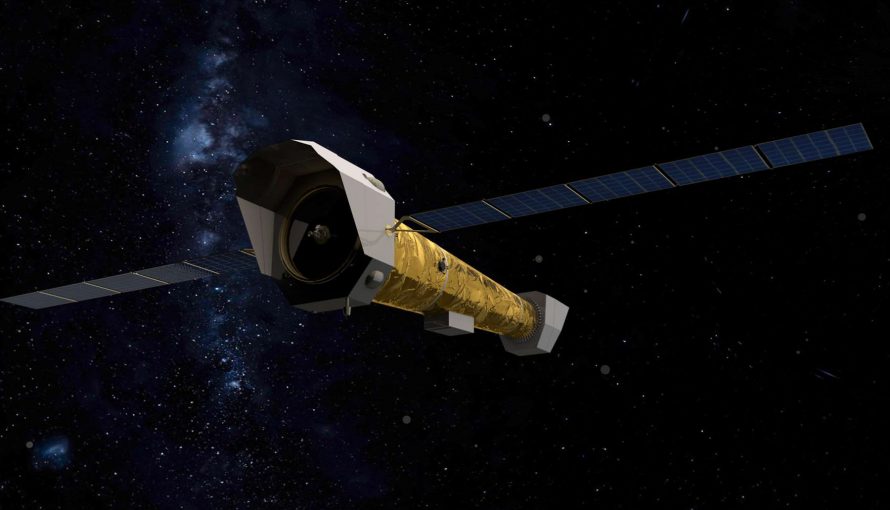ATHENA, a technical challenge for the new generation of X-ray telescope
The APC laboratory is heavily involved in the development of X-IFU, the high-resolution spectrometer for Athena, the future European X-ray space observatory currently scheduled for launch in 2031. The result described here is a further step in the development of the X-IFU readout chain.

Powerful sources of X-rays, extreme phenomena such as black holes, galaxy clusters and star explosions, are true archives that inform us about the major stages in the formation and evolution of the Universe. Observing these X-rays in these hot and energetic regions of the Universe is therefore a major challenge for high-energy astrophysics. However, since X-rays are absorbed by the Earth’s atmosphere, they can only be observed from space.
The future European space telescope Athena (Advanced Telescope for High ENergy Astrophysics) will therefore have the task of observing these X-ray sources with an unprecedented level of detail and sensitivity. Athena should be placed in orbit by 2031 by a European launcher. To fulfil its mission, Athena will be equipped with several new-generation instruments, including the X-ray Integral Field Unit (X-IFU) spectrometer. X-IFU is being developed and built by a French consortium.
The main specificity of X-IFU is its enormous spectral resolution, since the instrument should eventually be able to obtain a spectrum for each pixel, i.e. a resolution 100 times higher than current detectors. This unprecedented accuracy will be achieved by using superconducting X-ray microcalorimeters. These capture the energy left by an X-ray photon. It is this thermal fluctuation that is associated with the X-ray signal. The amplitude of this signal is very small, however, so the spectrometer must operate at very low temperatures. Part of the instrument is therefore immersed in a cryostat that reaches a temperature of less than 0.1 Kelvin.
This exceptional performance will enable scientists to determine the temperature, speed or chemical composition of gases in an observed zone, or to track the matter swallowed up by the gigantic black holes located at the heart of the most massive galaxies. But these major advances still require many innovative technologies to be developed.
The APC laboratory is particularly involved in the development of the X-IFU cryogenic reading chain. This publication also describes a new stage in the development by APC researchers of the warm front end electronics (WFEE) of the readout chain, i.e. the ‘hot’ part of the chain, located outside the cryostat.
The APC microelectronics team built prototypes of the signal amplifiers present on the WFEE part of the readout chain. Numerous measurements were then carried out on these amplifiers in order to characterise key parameters such as the gain, noise and bandwidth of these components. These models obtained are essential in order to propose, in the first instance, a numerical simulation of the WFEE of the readout chain, and then eventually of the entire detector.
Indeed, the development of projects of this size involves finding a compromise between the desired scientific performance (in this case, an unprecedented accuracy for X-ray measurement) and the technical constraints (in this case, an instrument maintained in orbit at very low temperature). Numerical simulators are thus indispensable tools for adjusting the properties of the instrument and defining increasingly precise technical specifications.
The result described in this scientific publication therefore represents an additional, but essential brick in the development of Athena.
References:
Prêle, Damien, Si Chen, Alexis Coleiro, Peggy Varniere, Philippe Peille, Laurent Ravera, et Christian Kirsch. « Warm front end electronic modelization for the X-IFU ATHENA readout chain simulation ». In Space Telescopes and Instrumentation 2020: Ultraviolet to Gamma Ray, 11444:114443U. International Society for Optics and Photonics, 2020. https://doi.org/10.1117/12.2560367
The LabEx UnivEarthS contributed to this research by funding the Young Team project MIMOSA (JE4).
- 4.5 billions years ago, the Earth’s early atmosphere was similar to present Venus [1/10]
- Observing supernovae: neutrino detectors to the rescue [2/10]
- At the origins of the Solar System, millimetre-sized crystals at the heart of certain meteorites [3/10]
- Kinetic Inductance Detectors, a promising technology for precision astronomy [4/10]
- Light-speed seismology to prevent earthquakes [5/10]
- ATHENA, a technical challenge for the new generation of X-ray telescope [6/10]
- Dune fields, a key to understanding the climate of other “Earths” in the Solar System [7/10]
- SVOM/ECLAIRs space instrument will pave the way to a deeper understanding of ultra-long gamma-ray bursts [8/10]
- InSight/SEIS probes further into the heart of Mars [9/10]
- The search for dark matter compatible with the search for supernovae [10/10]
